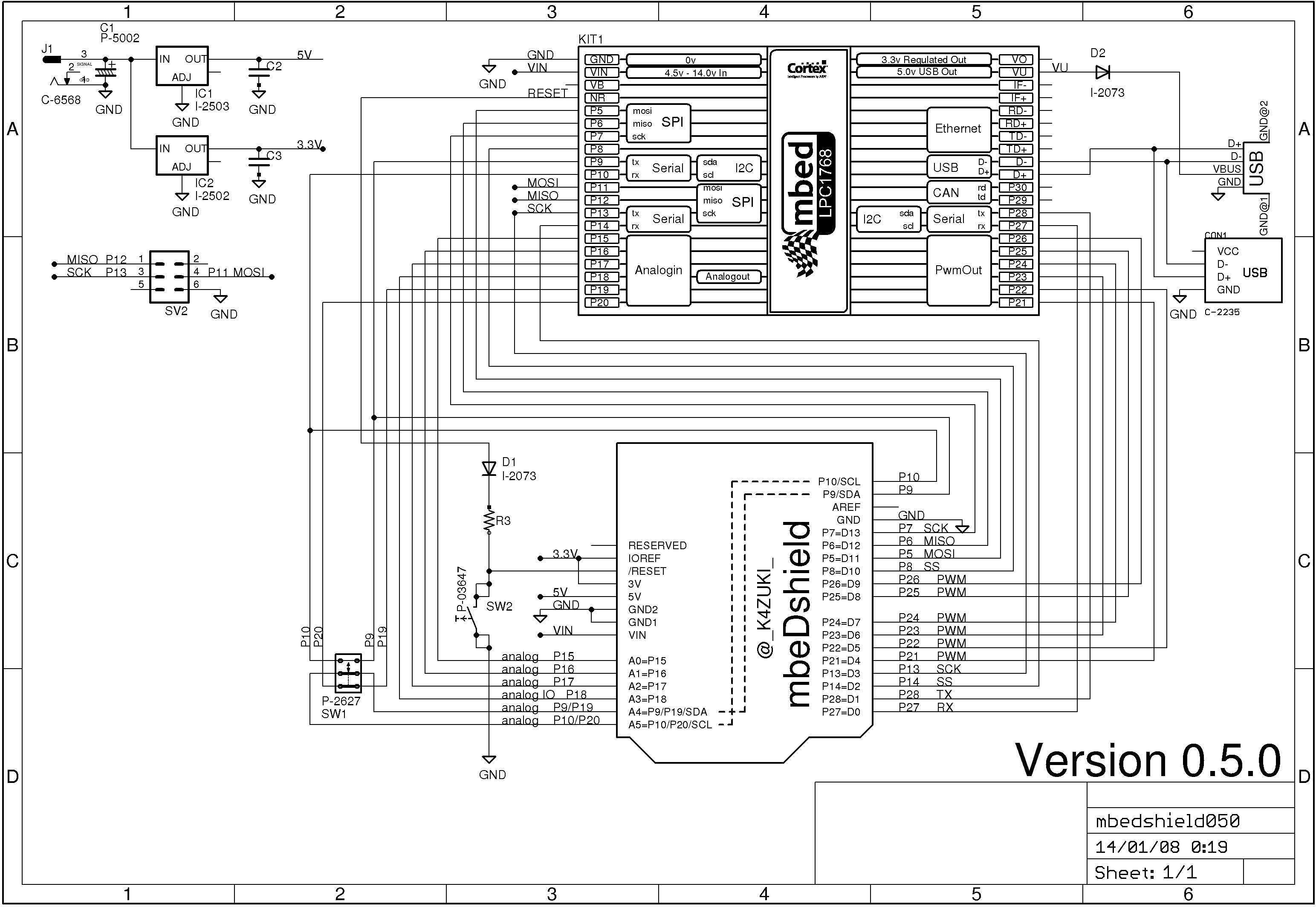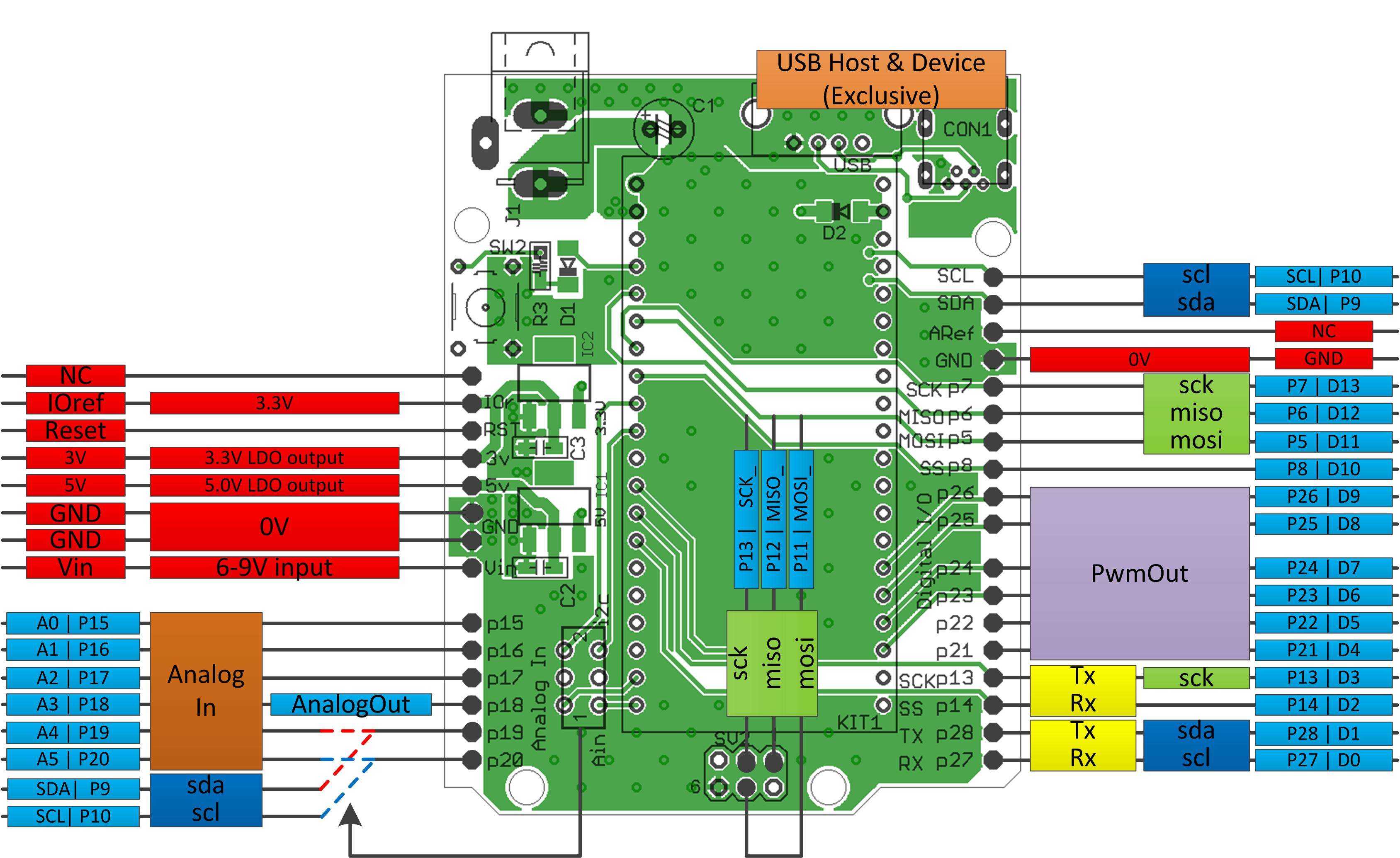The official mbed C/C SDK provides the software platform and libraries to build your applications.
Fork of mbed by
(01.May.2014) started sales! http://www.switch-science.com/catalog/1717/
(13.March.2014) updated to 0.5.0
This is a pin conversion PCB from mbed 1768/11U24 to arduino UNO.
- So if you have both mbed and arduino shields, I guess you would be happy with such a conversion board :)
Photos
- Board photo vvv

- Schematic photo vvv

- Functionality photo vvv

Latest eagle files
PCB >> /media/uploads/k4zuki/mbedshield050.brd
SCH >> /media/uploads/k4zuki/mbedshield050.sch
BIG changes from previous version
- Ethernet RJ45 connector is removed.
- http://mbed.org/components/Seeed-Ethernet-Shield-V20/ is the biggest hint to use Ethernet!
MostALL of components can be bought at Akizuki http://akizukidenshi.com/- But sorry, they do not send parts to abroad
- Pinout is changed!
| arduino | 0.4.0 | 0.5.0 |
|---|---|---|
| D4 | p12 | p21 |
| D5 | p11 | p22 |
| MOSI_ | none | p11 |
| MISO_ | none | p12 |
| SCK_ | none | p13 |
This design has bug(s)
- I2C functional pin differs between 1768 and 11U24.
Fixed bugs here
- MiniUSB cable cannot be connected on mbed if you solder high-height electrolytic capacitor on C3.
- http://akizukidenshi.com/catalog/g/gP-05002/ is the solution to make this 100% AKIZUKI parts!
- the 6-pin ISP port is not inprimented in version 0.4.0
it will be fixed in later version 0.4.1/0.4.2/0.5.0This has beenfixed
I am doing some porting to use existing arduino shields but it may faster if you do it by yourself...
you can use arduino PinName "A0-A5,D0-D13" plus backside SPI port for easier porting.
To do this you have to edit PinName enum in
- "mbed/TARGET_LPC1768/PinNames.h" or
- "mbed/TARGET_LPC11U24/PinNames.h" as per your target mbed.
here is the actual list: This list includes define switch to switch pin assignment
part_of_PinNames.h
USBTX = P0_2,
USBRX = P0_3,
//from here mbeDshield mod
D0=p27,
D1=p28,
D2=p14,
D3=p13,
#ifdef MBEDSHIELD_050
MOSI_=p11,
MISO_=p12,
SCK_=p13,
D4=p21,
D5=p22,
#else
D4=p12,
D5=p11,
#endif
D6=p23,
D7=p24,
D8=p25,
D9=p26,
D10=p8,
D11=p5,
D12=p6,
D13=p7,
A0=p15,
A1=p16,
A2=p17,
A3=p18,
A4=p19,
A5=p20,
SDA=p9,
SCL=p10,
//mbeDshield mod ends here
// Not connected
NC = (int)0xFFFFFFFF
Diff: Timeout.h
- Revision:
- 11:1c1ebd0324fa
- Parent:
- 9:cf0d45ce28a6
- Child:
- 27:7110ebee3484
--- a/Timeout.h Thu May 14 14:44:00 2009 +0000
+++ b/Timeout.h Fri Aug 28 12:10:11 2009 +0000
@@ -1,7 +1,8 @@
/* mbed Microcontroller Library - Timeout
- * Copyright (c) 2007-2008, sford
- */
-
+ * Copyright (c) 2007-2009 ARM Limited. All rights reserved.
+ * sford
+ */
+
#ifndef MBED_TIMEOUT_H
#define MBED_TIMEOUT_H
@@ -13,6 +14,28 @@
* A Timeout is used to call a function at a point in the future
*
* You can use as many seperate Timeout objects as you require.
+ *
+ * Example:
+ * > // Blink until timeout.
+ * >
+ * > #include "mbed.h"
+ * >
+ * > Timeout timeout;
+ * > DigitalOut led(LED1);
+ * >
+ * > int on = 1;
+ * >
+ * > void attimeout() {
+ * > on = 0;
+ * > }
+ * >
+ * > int main() {
+ * > timeout.attach(&attimeout, 5);
+ * > while(on) {
+ * > led = !led;
+ * > wait(0.2);
+ * > }
+ * > }
*/
class Timeout : public Ticker {
@@ -77,10 +100,10 @@
protected:
- virtual void handler();
-
-};
+ virtual void handler();
-}
+};
+
+} // namespace mbed
#endif
